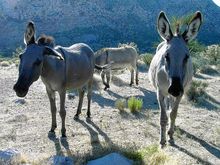Prompted in part by several recent traffic crashes with burros, the Mohave County supervisors will discuss ways to reduce the burro population in the Black Mountains.

Wild burros in desert habitat
After recent traffic crashes with burros, the Mohave County supervisors are discussing ways to reduce the burro population which has increased from 817 in 1996 to between 1746 and 1827 in the Black Mountain area.
District 5 Sup. Steve Moss is asking staff to contact the Bureau of Land Management to reduce the burro population to 817. One option is to seek legislation to allow state agencies to issue hunting permits to bring the population under control. Another option is to file a lawsuit against BLM.
Moss said hunting permits would be an extreme solution and not something he wants but he is bringing the issue before the board to get BLMâs attention. BLM could sterilize the male burros or remove some of the burros to other areas.
âDoing nothing is not an option,â Moss said. âSomeone is going to die if nothing is done.â
Three burros were killed Dec. 27 in two separate incidents on the Bullhead Parkway. Both drivers were unhurt but their cars were heavily damaged. Another burro had to be euthanized after it collided with a car in February 2015, also on the Parkway. A herd of about nine burros have recently been seen on the Parkway grazing on the side of the road and in the center median.
Under the BLMâs management plan in 1981, the local burro populations was set at about 400. In 1996, the Black Mountain Ecosystem plan set the population at 817. According to Arizona Game and Fish, the burro population is now between 1,746 and 1,827 in the Black Mountains Herd Management Area.
Moss said the BLMâs adoption program is not sufficient to keep the burro population under control. State and local agencies cannot manage the burro population despite their duty to protect public safety, Moss said.
Moss added that burros are not indigenous in Arizona, coming from North Africa to assist miners in the 19tth century. The burros have an impact on native wildlife such as bighorn sheep, quail and mule deer by eating vegetation as well as damaging the desert habitat.
According to the BLM, the agency rounds up wild horses and burros to adopt to people who can provide long-term care. Without natural predators, burro herd sizes can double in four years. The area has one of the largest burro populations in the nation. Since 1973, BLM has adopted out more than 207,000 wild horses and burros.
Sierra Club Grand Canyon Chapter Director Sandy Bahr said that public safety should always be addressed but the state does not have the authority to issue hunting permits for burros.
